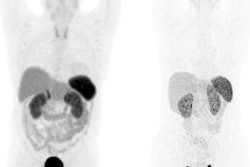Thursday, December 1 | 9:30 a.m.-10:30 a.m. | R3-SSNMMI07-2 | Room S501
Patients with neuroendocrine tumors (NETs) who are at high risk for poor outcomes following peptide receptor radionuclide therapy (PRRT) can be identified with semi-automated quantitative analysis of gallium-68 (GA-68) DOTATATE PET/CT scans, according to research to be presented in this session.Researchers at the University of Pennsylvania Perelman School of Medicine led by presenter Dr. Hwan Lee examined the prognostic value of quantitative semi-automatic Ga-68 DOTATATE PET/CT analysis in 91 NET patients following Lu-177 DOTATATE (Lutathera) treatment. They calculated the total tumor volume (TTV), maximum standardized uptake value (SUVmax), and average uptake in the least avid lesion (SUVmin) on Ga-68 DOTATATE PET/CT for each patient prior to treatment with a semiautomatic tumor delineation method. Progression-free survival (PFS) and overall survival (OS) among the patients based on the imaging parameters were compared.
The median clinical follow-up was 21.8 months, during which disease progression and death occurred in 45 (49%) and 16 (18%) patients. Significantly shorter PFS was observed in patients with higher TTV (median 13.8 months vs. 26.5 months), lower SUVmax (14.1 months vs. 24.2 months), and lower SUVmin (7 months vs. 24.2 months), according to the results. Similarly, higher TTV (hazard ratio [HR], 2.4), lower SUVmax (HR, 2.2), and lower SUVmin (HR, 2.8) were predictive of shorter PFS. On multivariate analysis, higher TTV (HR, 2.9) and lower SUVmin (HR, 3) remained predictive of shorter PFS. For OS, only higher TTV was found to be predictive of mortality risk, according to the researchers.
In a post-hoc Kaplan-Meier analysis, patients with at least one high-risk feature (high TTV or low SUVmin) showed shorter PFS (median 9.9 months vs. 26.5 months) and OS (34.1 months vs. > 40 months), which may be the most convenient method to apply in clinical practice, Lee noted.
Stop by this Thursday presentation to learn more.





















